1. Be Aware of Your Posture
Body awareness is something we learn as we get older, knowing where we are in our space or paying attention to what we do. When we have body awareness, we can self-correct bad postures. Ask your students if they are studying while sitting on their bed, hunched forward off the couch, or complaining of more pain after sitting in a certain position.
2. Set Up Your Desk Properly
Most homes are not set up to have child size desks available. When picking your area for e-learning, make sure it is the appropriate size for your child. Sit with feet flat on the floor and pick a stable surface to sit on. Adjust the height of your desk or table so the child can look straight ahead at the computer screen. You can use a stack of books to raise the height of the laptop. Try to have forearms, chin and thighs all be in flat lines when sitting at your designated desk space.
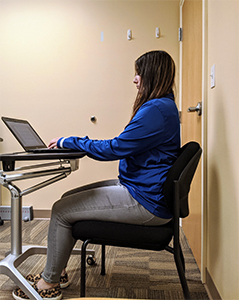
Example of setting up your child’s desk
3. Set Timers to Take Breaks
Set a timer for every 30 minutes to give your child a break to move around. They can walk around the room, use the restroom or get a drink of water. The intention of the break is to move out of whatever posture they have been sitting in. Even little movements during these breaks can help prevent future stiffness!
4. Stretches That Can Help Ease Back or Neck Pain
- Butterfly Wing Stretch
- Begin with hands behind your head and elbows out to the side. Slowly bring elbows toward the center while keeping hands on head and then return to starting position while also squeezing shoulder blades together. Then repeat. You should feel a stretch across your chest with elbows apart and may feel a stretch in mid back with elbows together. Remember to keep your shoulders down. Hold each position for 5-10 seconds and repeat 10 repetitions each direction.

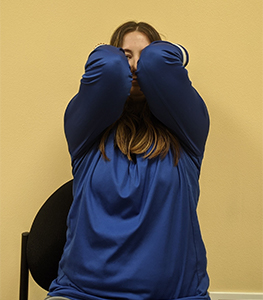
- Chin Tuck
- Begin by sitting up straight. While keeping eyes level with horizon, pull chin back underneath your head. You may feel a stretch in back of neck near the base of your skull. Hold position for 5-10 seconds then relax. Perform 10 repetitions.
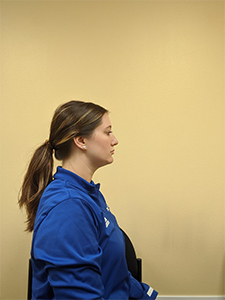
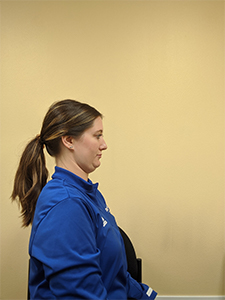
- Cat/Camel Stretches
- Begin on hands and knees with hands under your shoulders and knees under hips. Try to arch your back up toward the ceiling, then reverse by trying to sag your back toward the floor. Try to feel the movement throughout your entire spine. Perform 10-20 repetitions. Movement should be slow and controlled.
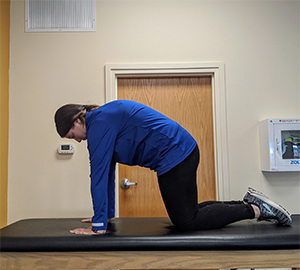
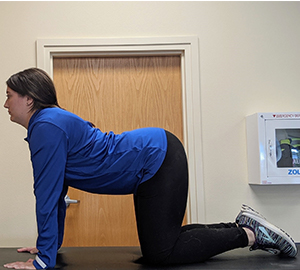
- Lower Body Rotation
- Begin lying on your back with knees bent and feet flat on floor. Keep shoulders and upper back flat on floor while allowing both knees to fall to the side. Only rotate your knees to a comfortable position or stretch and hold for 2-3 breaths then switch knees to opposite side. Perform 10 repetitions to each side. A gentle stretch should be felt in your lower back during this exercise.
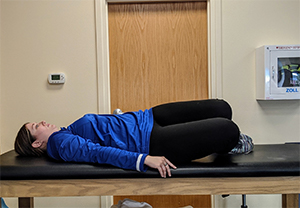
- Seated Hip Stretch
- Sit up straight in your chair with feet flat. Bend one leg and cross your ankle over your knee. Gently let the knee fall out toward the side and ground- if you feel a stretch here, hold this position. If you don’t feel much, slowly lean forward in your chair keeping your back straight until a stretch is felt in the “back pocket” area of your hip on the leg that is crossed. Hold stretch for 20-30 seconds and repeat on other side.
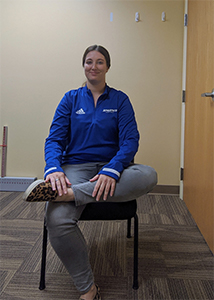
Use these tips to help your student return to school pain-free! If you begin to have neck or back pain, contact an Athletico clinic for a free assessment. Assessments are available in clinic and virtually through our telehealth platform.
The Athletico blog is an educational resource written by Athletico employees. Athletico bloggers are licensed professionals who abide by the code of ethics outlined by their respective professional associations. The content published in blog posts represents the opinion of the individual author based on their expertise and experience. The content provided in this blog is for informational purposes only, does not constitute medical advice and should not be relied on for making personal health decisions.
About the Author:
Tara Hackney, a physical therapist in Marion, IA, enjoys working with all patient types, especially gymnasts, cheerleaders, and dancers. She is the prominent blogger for Athletico's Gymnastic/Cheer Program. With an orthopedic specialization and training in dry needling and Graston technique, Tara hopes to answer your questions about injuries and injury prevention in an easy-to-understand manner. She hopes to ease fears surrounding pain and injuries, address concerns about recovery, and provide tips to prevent injury. In her free time, she enjoys spending time with her dog, reading, and watching her nephews play sports.

 width="900"
height="356"
>
width="900"
height="356"
>

1 Comment
Sumita Mukherjee
This is so nice of you to think about the well-being of students. Indeed many have faced these problems during their class, and most of them usually just change their body position. It is effective but only for a limited time. I would definitely recommend these to my students as well as teachers for their ultimate effort.